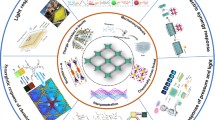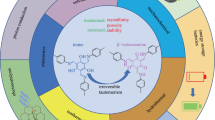Abstract
MCM-41 mesoporous silica has been functionalized with aromatic carboxylic acids salicylic acid (Sal) and 2-hydroxyl-3-methylbenzoic acid (HMBA) through co-condensation approach of tetraethoxysilane (TEOS) in the presence of the cetyltrimethylammonium bromide (CTAB) surfactant as a template. Organic ligands salicylic acid or 2-hydroxyl-3-methylbenzoic acid grafted to the coupling agent 3-(triethoxysilyl)-propyl isocyanate (TEPIC) was used as the precursor for the preparation of an organic–inorganic hybrid materials. Novel organic–inorganic mesoporous luminescent hybrid containing Ln3+ (Tb3+, Eu3+) complexes covalently attached to the functionalized ordered mesoporous MCM-41, which were designated as Ln-Sal-MCM-41 and Ln-HMBA-MCM-41, respectively, were obtained by sol–gel process. The luminescence properties of these resulting materials were characterized in detail, and the results reveal that luminescent mesoporous materials have high surface area, uniformity in the mesopore structure and good crystallinity. Moreover, the mesoporous material covalently bonded Tb3+ complex (Tb-Sal-MCM-41 and Tb-HMBA-MCM-41) exhibit the stronger characteristic emission of Tb3+ and longer lifetime than the corresponding Eu-containg materials Eu-Sal-MCM-41 and Eu-HMBA-MCM-41 due to the triplet state energy of modified organic ligands Sal-TEPIC and HMBA-TEPIC match with the emissive energy level of Tb3+ very well. In addition, the luminescence lifetime and emission quantum efficiency of 5D0 Eu3+ excited state also indicates the efficient intramolecular energy transfer process in Tb-SAL-MCM-41 and Tb-HMBA-MCM-41.







Similar content being viewed by others
References
DeSá GF, Malta OL, De Mello Doneg, á C, Simas AM, Longo RL, Santa-Cruz PA, da Silva EF Jr (2000) Spectroscopic properties and design of highly luminescent lanthanide coordination complexes. Coord Chem Rev 196:165
Sabbatini N, Guardingli M, Lehn JM (1993) Luminescent lanthanide complexes as photochemical supramolecular devices. Coord Chem Rev 123:201
Blasse G (1995) Luminescent materials: is there still news? J Alloy Compd 225:529
Lehn JM (1990) Perspectives in supramolecular chemistry—from molecular recognition towards molecular information processing and self-organization. Angew Chem Int Ed Engl 29:1304
Serra QA, Rosa ILV, Medeiros CL, Zaniquell MED (1994) Luminescent properties of Eu3+ b-diketonate complexes supported on Langmuir–Blodgett films. J Lumin 60–61:112
Tanner PA, Yan B, Zhang HJ (2000) Preparation and luminescence properties of sol–gel hybrid materials incorporated with europium complexes. J Mater Sci 35:4325
Koslova NI, Viana B, Sanchez C (1993) Rare-earth-doped hybrid siloxane-oxide coatings with luminescent properties. J Mater Chem 3:111
Wang QM, Yan B (2004) From molecules to materials: a new way to construct luminescent chemical bonded hybrid systems based with ternary lanthanide complexes of 1,10-phenanthroline. Inorg Chem Commun 7:1124
Zhao LM, Yan B (2005) A novel path to luminescent hybrid molecular materials: modifying the hydroxyl group of 6-hydroxynicotinic acid by grafting to a silica network. Appl Organomet Chem 19:1060
Yan B, Zhao LM (2005) Construction of luminescent terbium inorganic/organic molecular-based hybrids from modified functional bridge ligand. Mater Lett 59:795
Wang QM, Yan B (2006) Assembly of luminescent hybrids from co-polymers bearing functional 4-vinyl pyridine and europium aromatic carboxylate. J Photochem Photobiol, A: Chem 177:1
Wang QM, Yan B (2005) A Novel Way to prepare luminescent terbium molecular-scale hybrid materials: modified heterocyclic ligands covalently bonded with silica.. Cryst Growth Des 5:497
Wang QM, Yan B (2005) Construction of lanthanide luminescent molecular-based hybrid material using modified functional bridge chemical bonded with silica. J Photochem Photobiol, A: Chem 175:159
Yan B, Wang FF (2007) Molecular design and photo-physics of quaternary hybrid terbium centered systems with novel functional di-urea linkages of strong chemical bonds through hydrogen transfer addition. J Organomet Chem 692:2395
Sanchez C, Lebeau B, Chaput F, Boilot JP (2003) Optical properties of functional hybrid organic–inorganic nanocomposites. Adv Mater 15:1969
Zhang WH, Shi JL, Wang LZ, Yan DS (2000) Preparation and characterization of ZnO clusters inside mesoporous silica. Chem Mater 12:1408
Yu J, Shi JL, Wang LZ, Ruan ML, Yan DS (2001) Preparation of high thermal stability MCM-41 in the low surfactant/silicon molar ratio synthesis systems. Mater Lett 48:112
Maschmeyer T, Rey F, Sankar G, Thomas JM (1995) Heterogeneous catalysts obtained by grafting metallocene complexes onto mesoporous silica. Nature 378:159
Burch R, Cruise N, Gleeson D, Tsang SC (1996) Surface-grafted manganese-oxo species on the walls of MCM-41 channels—a novel oxidation catalyst. Chem Commun, pp 951–952
Minoofar PN, Hernandez R, Chia S, Dunn B, Zink JI, Franville AC (2002) Placement and characterization of pairs of luminescent molecules in spatially separated regions of nanostructured thin films. J Am Chem Soc 124:14388
Mitchell-Koch JT, Borovith AS (2003) Immobilization of a Europium Salen complex within porous organic hosts: modulation of luminescence properties in different chemical environments. Chem Mater 15:3490
Maria LC, Frances LC, Garcia H, Marti V, Scaiano JC (1996) Intrazeolite photochemistry. 13. Photophysical properties of bulky 2,4,6-triphenylpyrylium and tritylium cations within large- and extra-large-pore zeolites. J Phys Chem 100:18152
Xu QH, Li LS, Li B, Yu JH, Xu RR (2000) Encapsulation and luminescent property of tetrakis (1-(2-thenoyl)-3,3,3-trifluoracetate) europium N-hexadecyl pyridinium in modified Si-MCM-41. Micropor Mesopor Mater 38:351
Gago S, Fernandes JA, Rainho JP, Sá Ferreira RA, Pillinger M, Valente AA, Santos TM, Carlos LD, Ribeiro-Claro PJA, Goncalves IS (2005) Highly luminescent tris(b-diketonate)europium(III) complexes immobilized in a functionalized mesoporous silica. Chem Mater 17:5077
Li HR, Lin J, Fu LS, Guo JF, Meng QG, Liu FY, Zhang HJ (2002) Phenanthroline-functionalized MCM-41 doped with europium ions. Micropor Mesopor Mater 55:103
Sun LN, Zhang HJ, Peng CY, Yu JB, Meng QG, Fu LS, Liu FY, Guo XM (2006) Covalent linking of near-infrared luminescent ternary lanthanide (Er3+, Nd3+, Yb3+) complexes on functionalized mesoporous MCM-41 and SBA-15. J Phys Chem B 110:7249
Zhang JY, Luz Z, Goldfarb D (1997) EPR studies of the formation mechanism of the mesoporous materials MCM-41 and MCM-50. J Phys Chem B 101:7087
Hukkamäki J, Suvanto S, Suvanto M, Pakkanen TT (2004) Influence of the pore structure of MCM-41 and SBA-15 silica fibers on atomic layer chemical vapor deposition of cobalt carbonyl. Langmuir 20:10288
Bourlinos AB, Karakostas Th, Petridis D (2003) “Side chain” modification of MCM-41 silica through the exchange of the surfactant template with charged functionalized organosiloxanes: an efficient route to valuable reconstructed MCM-41 derivatives. J Phys Chem B 107:920
Sun LN, Yu JB, Zhang HJ, Meng QG, Ma E, Peng CY, Yang KY (2007) Near-infrared luminescent mesoporous materials covalently bonded with ternary lanthanide [Er(III), Nd(III), Yb(III), Sm(III), Pr(III)] complexes. Micropor Mesopor Mater 98:156
Everett DH (1972) Manual of symbols and terminology for physicochemical quantities and units, appendix ii: definitions, terminology and symbols in colloid and surface chemistry. Pure Appl Chem 31:577
Sing KSW, Everett DH, Haul RAW, Moscow L, Pierotti RA, Rouquerol J, Siemieniewska T (1985) Reporting physisorption data for gas/solid systems with special reference to the determination of surface area and porosity. Pure Appl Chem 57:603
Lim MH, Stein A (1999) Comparative studies of grafting and direct syntheses of inorganic–organic hybrid mesoporous materials. Chem Mater 11:3285
Zhang WH, Lu XB, Xiu JH, Hua ZL, Zhang LX, Robertson M, Shi JL, Yan DS, Holmes JD (2004) Synthesis and characterization of bifunctionalized ordered mesoporous materials. Adv Funct Mater 14:544
Peng CY, Zhang HJ, Meng QG, Li HR, Yu JB, Guo JF, Sun LN (2005) Synthesis and luminescence properties of SBA-15 functionalized with covalently bonded ternary europium complex. Inorg Chem Commun 8:440
Hu QY, Hampsey JE, Jiang N, Li CJ, Lu YF (2005) Surfactant-templated organic functionalized mesoporous silica with phosphino ligands. Chem Mater 17:1561
Ferreira RAS, Carlos LD, Goncalves RR, Ribeiro SJL, Bermudez VD (2001) Energy-transfer mechanisms and emission quantum yields in Eu3+-based siloxane-poly(oxyethylene) nanohybrids. Chem Mater 13:2991
Crosby GA, Whan RE, Alire RM (1961) Intramolecular energy transfer in rare earth chelates. Role of the triplet state. J Chem Phys 34:743
Yan B, Zhang HJ, Wang SB, Ni JZ (1998) Intramolecular energy transfer mechanism between ligands in ternary rare earth complexes with aromatic carboxylic acids and 1,10-phenanthroline. J Photochem Photobiol, A: Chem 116:209
Latva M, Takal H, Mukkala V, Matachescuc C, Rodriguez-Ubisd JC, Kankarea J (1997) Correlation between the lowest triplet state energy level of the ligand and lanthanide (III) luminescence quantum yield. J Lumin 75:149
Dexter DL (1953) A Theory of sensitized luminescence in solids. J Chem Phys 21:836
Yan B, Zhang HJ, Ni JZ (1998) Photophysical properties of some binary and ternary complexes of rare earth ions with aminobenzoic acids and 1,10-phenanthroline. Monafsh Chem 129:151
Miranda Jr P, Zukerman-Schpector J, Isolani PC, Vicentini G, Zinner LB (2002) Synthesis and structure of lanthanide picrates with trans-1,3-dithiane-1,3-dioxide. J Alloys Compd 344:141
Guo XM, Fu LS, Zhang HJ, Carlos LD, Peng CY, Guo JF, Yu JB, Deng RP, Sun LN (2005) Incorporation of luminescent lanthanide complex inside the channels of organically modified mesoporous silica via template-ion exchange method. New J Chem 29:1351
Soares-Santos PCR, Nogueira HIS, Félix V, Drew MGB, Ferreira RAS, Carlos LD, Trindade T (2003) Novel lanthanide luminescent materials based on complexes of 3-hydroxypicolinic acid and silica nanoparticles. Chem Mater 15:100
Teotonio ES, Espínola JGP, Brito HF, Malta OL, Oliveria SF, de Foria DLA, Izumi CMS (2002) Influence of the N-[methylpyridyl]acetamide ligands on the photoluminescent properties of Eu(III)-perchlorate complexes. Polyhedron 21:1837
Carlos LD, Messaddeq Y, Brito HF, Ferreira RAS, Bermudez VD, Ribeiro SJL (2000) Full-color phosphors from europium(III)-based organosilicates. Adv Mater 12:594
Hazenkamp MF, Blasse G (1990) Rare-earth ions adsorbed onto porous glass: luminescence as a characterizing tool. Chem Mater 2:105
Horrocks W De W, Sudnick DR (1979) Lanthanide ion probes of structure in biology. Laser-induced luminescence decay constants provide a direct measure of the number of metal-coordinated water molecules. J Am Chem Soc 101:334
Acknowledgements
This work was supported by the National Natural Science Foundation of China (20671072).
Author information
Authors and Affiliations
Corresponding author
Rights and permissions
About this article
Cite this article
Li, Y., Yan, B. Photophysical Properties of Lanthanide Hybrids Covalently Bonded To Functionalized MCM-41 by Modified Aromatic Carboxylic Acids. J Fluoresc 19, 191–201 (2009). https://doi.org/10.1007/s10895-008-0402-6
Received:
Accepted:
Published:
Issue Date:
DOI: https://doi.org/10.1007/s10895-008-0402-6




